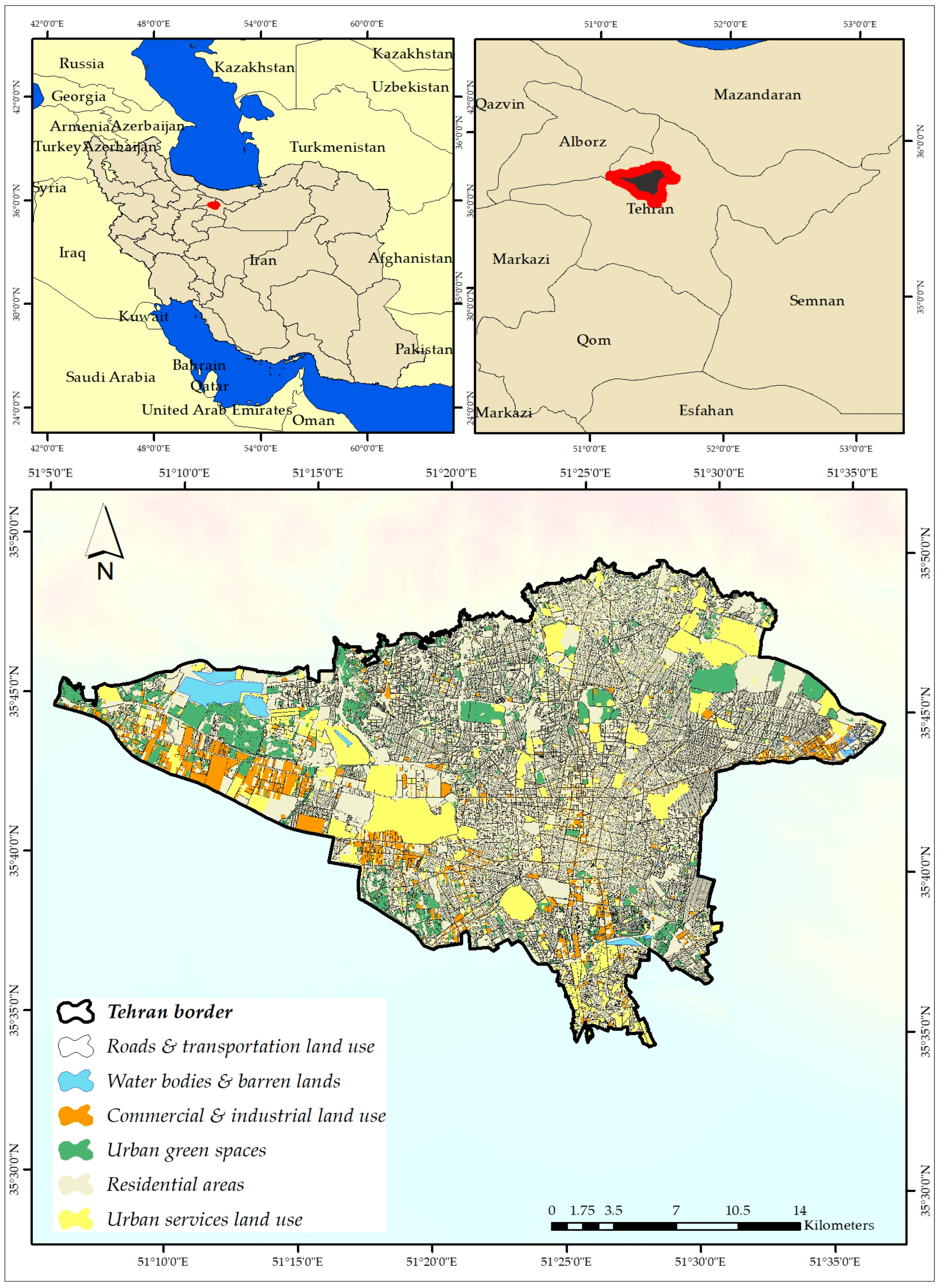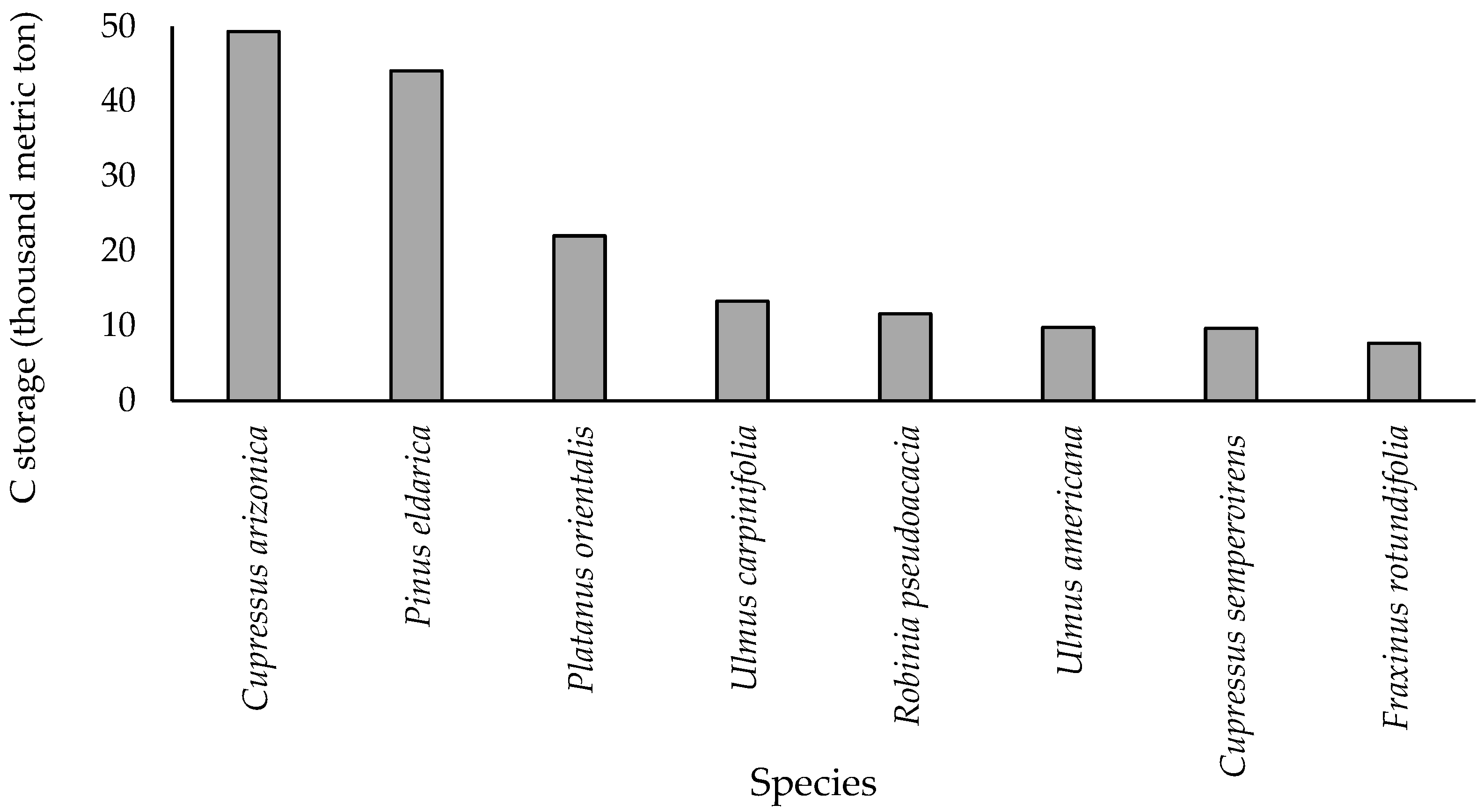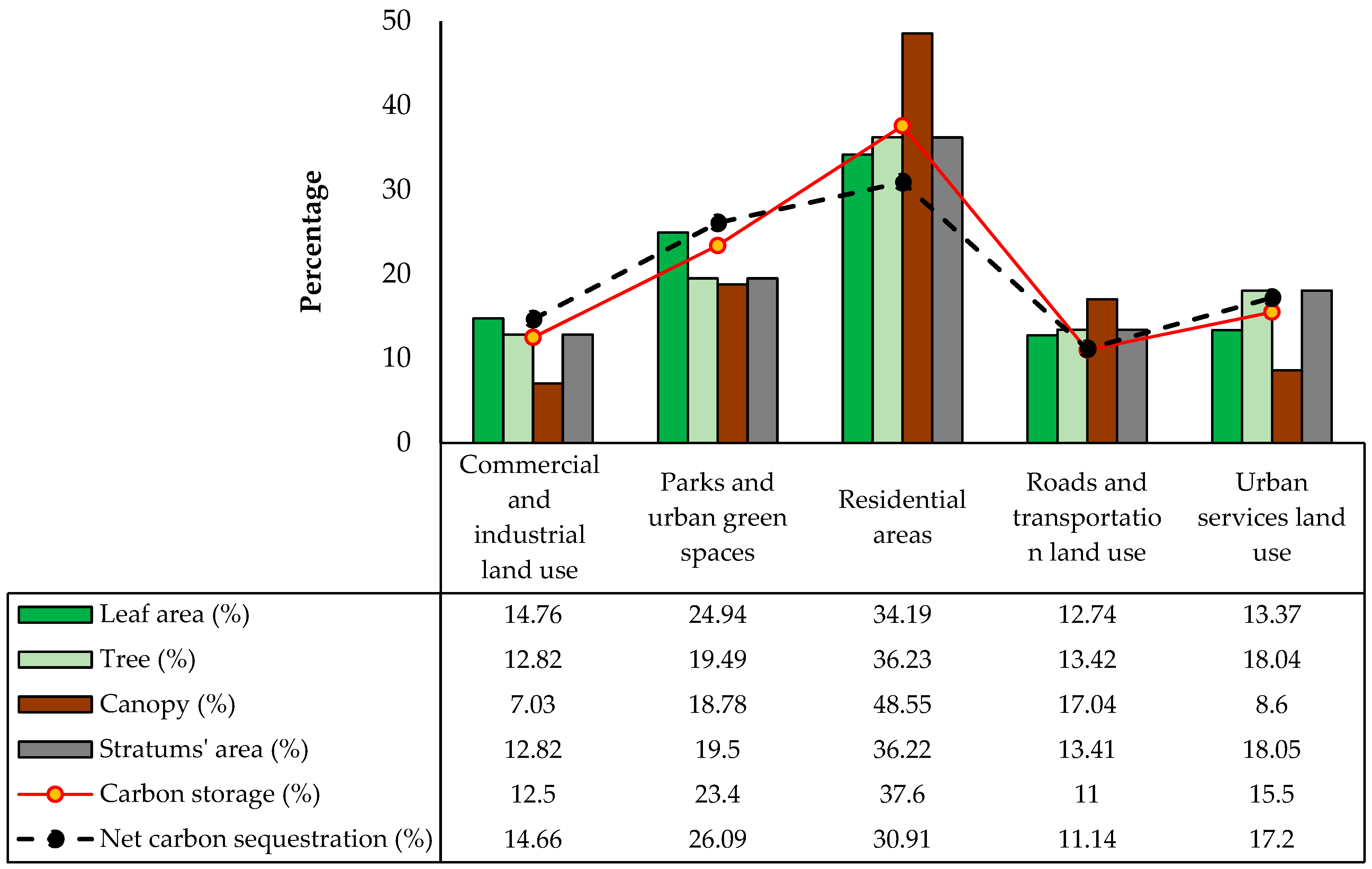Carbon Sequestration and Storage of Urban Trees in a Polluted Semiarid City
Abstract
1. Introduction
2. Materials and Methods
2.1. Study Area
2.2. Research Methods
2.2.1. i-Tree Eco Model
2.2.2. Model Development for the Study Area
- (1)
- Location information: This includes details such as the climate zone; latitude and longitude of the study area; elevation (meters above sea level); the number of leaf-on and leaf-off days of trees; and average daily temperature, rainfall, and snowfall levels, among other climate-related parameters.
- (2)
- Precipitation data: Hourly rainfall and snowfall data for the year 2018, captured from the Mehrabad Synoptic Station, were used. Additionally, other required climate data were automatically retrieved by the model from the National Climatic Data Center.
- (3)
- Air pollution data: Hourly data on the concentrations of major air pollutants (NO2, SO2, O3, PM10, PM2.5, and CO) were obtained from the Tehran Air Quality Control Company for the year 2018.
2.2.3. Determining the Number of Plots
2.2.4. Data Collection
2.3. Carbon Sequestration and Storage Ecosystem Services of Trees
3. Results and Discussion
3.1. Carbon Sequestration by Urban Trees in Tehran
3.2. Carbon Storage by Urban Trees in Tehran
3.3. Management Implications
3.4. Research Limitations
4. Conclusions
Author Contributions
Funding
Data Availability Statement
Acknowledgments
Conflicts of Interest
References
- Zhao, Q.; Yu, P.; Mahendran, R.; Huang, W.; Gao, Y.; Yang, Z.; Ye, T.; Wen, B.; Wu, Y.; Li, S.; et al. Global climate change and human health: Pathways and possible solutions. Eco-Environ. Health 2022, 1, 53–62. [Google Scholar] [CrossRef]
- Yin, S.; Gong, Z.; Gu, L.; Deng, Y.; Niu, Y. Driving forces of the efficiency of forest carbon sequestration production: Spatial panel data from the national forest inventory in China. J. Clean. Prod. 2022, 330, 129776. [Google Scholar] [CrossRef]
- Meyers, R.A. Encyclopedia of Sustainability Science and Technology; Springer: New York, NY, USA, 2012; Volume 6. [Google Scholar]
- Wang, Y.; Chang, Q.; Li, X. Promoting sustainable carbon sequestration of plants in urban greenspace by planting design: A case study in parks of Beijing. Urban For. Urban Green. 2021, 64, 127291. [Google Scholar] [CrossRef]
- Esperon-Rodriguez, M.; Rymer, P.D.; Power, S.A.; Barton, D.N.; Cariñanos, P.; Dobbs, C.; Eleuterio, A.A.; Escobedo, F.J.; Hauer, R.; Hermy, M.; et al. Assessing climate risk to support urban forests in a changing climate. Plants People Planet 2022, 4, 201–213. [Google Scholar] [CrossRef]
- Deljouei, A.; Abdi, E.; Marcantonio, M.; Majnounian, B.; Amici, V.; Sohrabi, H. The impact of forest roads on understory plant diversity in temperate hornbeam-beech forests of Northern Iran. Environ. Monit. Assess. 2017, 189, 392. [Google Scholar] [CrossRef] [PubMed]
- Farzadkia, M.; Yavary Nia, M.; Yavari Nia, M.; Shacheri, F.; Nourali, Z.; Torkashvand, J. Reduction of the environmental and health consequences of cigarette butt recycling by removal of toxic and carcinogenic compounds from its leachate. Environ. Sci. Pollut. Res. 2024, 31, 23942–23950. [Google Scholar] [CrossRef]
- Bindajam, A.A.; Hang, H.T.; Alshayeb, M.J.; Shohan, A.A.A.; Mallick, J. Evaluating the impact of urbanization on the urban heat islands through integrated radius and non-linear regression approach. Environ. Sci. Pollut. Res. 2024, 31, 44120–44135. [Google Scholar] [CrossRef]
- Nejatian, N.; Yavary Nia, M.; Yousefyani, H.; Shacheri, F.; Yavari Nia, M. The improvement of wavelet-based multilinear regression for suspended sediment load modeling by considering the physiographic characteristics of the watershed. Water Sci. Technol. 2023, 87, 1791–1802. [Google Scholar]
- NOAA. National Centers for Environmental Information, Annual 2023 Global Climate Report. 2024. Available online: www.ncei.noaa.gov/access/monitoring/monthly-report/global/202313 (accessed on 6 March 2024).
- Schulze, E.D.; Schulze, I. Sustainable foresting: Easier said than done. Science 2010, 327, 957. [Google Scholar] [CrossRef]
- Estruch, C.; Curcoll, R.; Morguí, J.A.; Segura-Barrero, R.; Vidal, V.; Badia, A.; Villalba, G. Exploring how the heterogeneous urban landscape influences CO2 concentrations: The case study of the Metropolitan Area of Barcelona. Urban For. Urban Green. 2024, 99, 128438. [Google Scholar] [CrossRef]
- Guo, Y.; Ren, Z.; Wang, C.; Zhang, P.; Ma, Z.; Hong, S.; He, X. Spatiotemporal patterns of urban forest carbon sequestration capacity: Implications for urban CO2 emission mitigation during China’s rapid urbanization. Sci. Total Environ. 2024, 912, 168781. [Google Scholar] [CrossRef] [PubMed]
- Lisboa, M.A.N.; da Silva, L.V.A.; da Silva Nascimento, A.; de Oliveira Silva, A.; Teixeira, M.R.A.; Ferreira, M.F.R.; Ferreira, S.C.; da Silva, A.C.; Colares, A.V.; Júnior, J.T. Diversity, structure, and carbon sequestration potential of the woody flora of urban squares in the Brazilian semiarid region. Trees For. People 2024, 16, 100561. [Google Scholar] [CrossRef]
- Nowak, D.J.; Crane, D.E.; Stevens, J.C. Air pollution removal by urban trees and shrubs in the United States. Urban For. Urban Green. 2006, 4, 115–123. [Google Scholar] [CrossRef]
- Nowak, D.J.; Cumming, A.B.; Twardus, D.; Hoehn, R.E.; Oswalt, C.M.; Brandeis, T.J. Urban forests of Tennessee, 2009. In General Technical Report. SRS–149; US Department of Agriculture Forest Service, Southern Research Station: Asheville, NC, USA, 2012; Volume 149, 52p. [Google Scholar]
- Nowak, D.; Crane, D.; Stevens, J.; Hoehn, R.; Walton, J.; Bond, J. A ground-based method of assessing urban forest structure and ecosystem services. Arboric. Urban For. 2008, 34, 347–358. [Google Scholar] [CrossRef]
- Hirabayashi, S.; Endreny, T.A. Surface and Upper Weather Pre-Processor for i-Tree Eco and Hydro. 2014. Available online: https://www.itreetools.org/eco/resources/Surface_weather_and_upper_air_preprocessor_description.pdf (accessed on 10 January 2024).
- Crippa, M.; Guizzardi, D.; Banja, M.; Solazzo, E.; Muntean, M.; Schaaf, E.; Vignati, E. CO2 Emissions of All World Countries; JRC Science for Policy Report, European Commission; EUR: Brussels, Belgium, 2022; p. 31182. [Google Scholar]
- Hazrati, M.; Malakoutikhah, Z. An unclear future for Iranian energy transition in light of the Re-imposition of sanctions. Oil Gas Energy Law 2019, 17, 1875–1892. [Google Scholar]
- Motlagh, S.H.B.; Pons, O.; Hosseini, S.A. Sustainability model to assess the suitability of green roof alternatives for urban air pollution reduction applied in Tehran. Build. Environ. 2021, 194, 107683. [Google Scholar] [CrossRef]
- Shahbazi, H.; Abolmaali, A.M.; Alizadeh, H.; Salavati, H.; Zokaei, H.; Zandavi, R.; Torbatian, S.; Yazgi, D.; Hosseini, V. An emission inventory update for Tehran: The difference between air pollution and greenhouse gas source contributions. Atmos. Res. 2022, 275, 106240. [Google Scholar] [CrossRef]
- Ali-Taleshi, M.S.; Bakhtiari, A.R.; Hopke, P.K. Particulate and gaseous pollutants in Tehran, Iran during 2015-2021: Factors governing their variability. Sustain. Cities Soc. 2022, 87, 104183. [Google Scholar] [CrossRef]
- Afarideh, F.; Ramasht, M.H.; Mortyn, G. Air pollution and topography in Tehran. AUC Geogr. 2023, 58, 157–171. [Google Scholar] [CrossRef]
- Toulabi Nejad, M.T.; Ghalehteimouri, K.J.; Talkhabi, H.; Dolatshahi, Z. The relationship between atmospheric temperature inversion and urban air pollution characteristics: A case study of Tehran, Iran. Discov. Environ. 2023, 1, 17–22. [Google Scholar] [CrossRef]
- Zarghamipour, M.; Malakooti, H.; Bordbar, M.H. Spatio-temporal Analysis of the factors affecting NOx concentration during the evaluation cycle of high pollution episodes in Tehran metropolitan. Atmos. Pollut. Res. 2024, 15, 102177. [Google Scholar] [CrossRef]
- Xie, Y.; Hirabayashi, S.; Hashimoto, S.; Shibata, S.; Kang, J. Exploring the spatial pattern of urban Forest ecosystem services based on i-tree eco and spatial interpolation: A case study of Kyoto City, Japan. Environ. Manag. 2023, 72, 991–1005. [Google Scholar] [CrossRef]
- US Forest Service. i-Tree Eco User’s Manual v6.0. 2021. Available online: https://www.itreetools.org/documents/275/EcoV6_UsersManual.2021.09.22.pdf (accessed on 10 January 2024).
- Khoshnoodmotlagh, S.; Daneshi, A.; Gharari, S.; Verrelst, J.; Mirzaei, M.; Omrani, H. Urban morphology detection and it’s linking with land surface temperature: A case study for Tehran Metropolis, Iran. Sustain. Cities Soc. 2021, 74, 103228. [Google Scholar] [CrossRef]
- Parsa, V.A.; Salehi, E.; Yavari, A.R.; van Bodegom, P.M. Analyzing temporal changes in urban forest structure and the effect on air quality improvement. Sustain. Cities Soc. 2019, 48, 101548. [Google Scholar] [CrossRef]
- Nowak, D.J. Understanding i-Tree: 2021 Summary of Programs and Methods; General Technical Report NRS-200-2021; U.S. Department of Agriculture, Forest Service, Northern Research Station Madison: Madison, WI, USA, 2021. [Google Scholar]
- Chow, P.; Rolfe, G.L. Carbon and hydrogen contents of short-rotation biomass of five hardwood species. Wood Fiber Sci. 1989, 21, 30–36. [Google Scholar]
- Aba, S.C.; Ndukwe, O.O.; Amu, C.J.; Baiyeri, K.P. The role of trees and plantation agriculture in mitigating global climate change. Afr. J. Food Agric. Nutr. Dev. 2017, 17, 12691–12707. [Google Scholar]
- Sardoei, A.S.; Tahmasebi, M.; Bovand, F.; Ghorbanpour, M. Exogenously applied gibberellic acid and benzylamine modulate growth and chemical constituents of dwarf schefflera: A stepwise regression analysis. Sci. Rep. 2024, 14, 7896. [Google Scholar] [CrossRef] [PubMed]
- Nowak, D.J.; Greenfield, E.J.; Hoehn, R.E.; Lapoint, E. Carbon storage and sequestration by trees in urban and community areas of the United States. Environ. Pollut. 2013, 178, 229–236. [Google Scholar] [CrossRef]
- Kaçmaz, G.; Alkan, M.O.; Çobankaya, H.; Şen, D. Assessment of ecosystem services provided by street trees: Burdur (Türkiye) city center. Ege Üniversitesi Ziraat Fakültesi Derg. 2023, 60, 221–234. [Google Scholar] [CrossRef]
- Attarod, P.; Sadeghi, S.M.M.; Pypker, T.G.; Bagheri, H.; Bagheri, M.; Bayramzadeh, V. Needle-leaved trees impacts on rainfall interception and canopy storage capacity in an arid environment. New For. 2015, 46, 339–355. [Google Scholar] [CrossRef]
- Pourreza, M.; Moradi, F.; Khosravi, M.; Deljouei, A.; Vanderhoof, M.K. GCPs-free photogrammetry for estimating tree height and crown diameter in Arizona cypress plantation using UAV-mounted GNSS RTK. Forests 2022, 13, 1905. [Google Scholar] [CrossRef]
- Sadeghi, S.M.M.; Attarod, P.; Van Stan, J.T.; Pypker, T.G. The importance of considering rainfall partitioning in afforestation initiatives in semiarid climates: A comparison of common planted tree species in Tehran, Iran. Sci. Total Environ. 2016, 568, 845–855. [Google Scholar] [CrossRef] [PubMed]
- Panahandeh, T.; Attarod, P.; Sadeghi, S.M.M.; Bayramzadeh, V.; Tang, Q.; Liu, X. The performance of the reformulated Gash rainfall interception model in the Hyrcanian temperate forests of northern Iran. J. Hydrol. 2022, 612, 128092. [Google Scholar] [CrossRef]
- Brofas, G.; Karetsos, G.; Dimopoulos, P.; Tsagari, C. The natural environment of Cupressus sempervirens in Greece as a basis for its use in the Mediterranean region. Land Degrad. Dev. 2006, 17, 645–659. [Google Scholar] [CrossRef]
- Jazirei, M.H. Dryland Afforestation; University of Tehran: Tehran, Iran, 2009; pp. 167–345. 440p. [Google Scholar]
- Bao, Z.; Ma, J. On the design and construction of low-carbon plant landscape. Chin. Landsc. Archit. 2011, 1, 7–10. [Google Scholar]
- Weissert, L.F.; Salmond, J.A.; Schwendenmann, L. Photosynthetic CO2 uptake and carbon sequestration potential of deciduous and evergreen tree species in an urban environment. Urban Ecosyst. 2017, 20, 663–674. [Google Scholar] [CrossRef]




| Land Use Classes | Description | No. of Plots | No. of Inaccessible Plots | Total Area (ha) |
|---|---|---|---|---|
| Commercial and industrial land use | Industrial and commercial centers | 20 | 0 | 3375 |
| Parks and urban green spaces | Parks, open areas, and urban forests | 42 | 2 | 5213 |
| Residential areas | Family and mixed residences | 141 | 6 | 25,732 |
| Roads and transportation land use | Roads and transportation system lands | 76 | 3 | 15,706 |
| Urban services land use | Hospitals, universities, education, and cultural centers | 51 | 3 | 8996 |
| Study area (total) | Tehran city | 330 | 14 | 59,023 |
| Land Use Classes | Net Carbon Sequestration (t yr−1) | CO2 Equivalent (t yr−1) | Net Carbon Sequestration (t yr−1 ha−1 of the Study Area) | CO2 Equivalent (t ha−1 yr−1) |
|---|---|---|---|---|
| Commercial and industrial land use | 8809.5 | 32,304.4 | 0.89 | 3.27 |
| Parks and urban green spaces | 15,680.6 | 57,500.7 | 3.06 | 11.21 |
| Residential areas | 18,578.6 | 68,127.7 | 0.75 | 2.73 |
| Roads and transportation land use | 6697.1 | 24,558.3 | 0.75 | 2.76 |
| Urban services land use | 10,336.0 | 37,902.2 | 1.18 | 4.32 |
| Study area (total) | 60,101.8 | 220,393.3 | 1.04 | 3.82 |
| Species | Number | Leaf Area (ha) | Carbon Sequestration (t yr−1) | Carbon Sequestration (t yr−1 ha−1 of Leaf Area) |
|---|---|---|---|---|
| Cupressus arizonica | 666,802 | 1582.9 | 11,890 | 7.51 |
| Cupressus sempervirens L. var. horizontalis | 249,201 | 442.7 | 3110 | 7.00 |
| Platycladus orientalis | 515,493 | 579.7 | 3110 | 5.36 |
| Robinia pseudoacacia | 711,562 | 1087.1 | 3980 | 3.66 |
| Ulmus americana | 246,165 | 1056.2 | 3120 | 2.95 |
| Fraxinus rotundifolia | 335,787 | 1181.0 | 2890 | 2.45 |
| Pinus eldarica | 928,223 | 6205.5 | 8990 | 1.45 |
| Platanus orientalis | 595,362 | 4310.4 | 5099 | 1.18 |
| Land Use Classes | Carbon Storage (t) | CO2 Equivalent (t) | CO2 Equivalent (t ha−1) | CO2 Equivalent (t ha−1) |
|---|---|---|---|---|
| Commercial and industrial land use | 31,909.8 | 117,002.6 | 3.16 | 11.57 |
| Parks and urban green spaces | 59,565.1 | 218,405.5 | 11.43 | 41.90 |
| Residential areas | 95,764.6 | 351,136.8 | 3.72 | 13.65 |
| Roads and transportation land use | 27,891.7 | 102,269.5 | 3.09 | 11.33 |
| Urban services land use | 39,447.4 | 144,640.4 | 4.38 | 16.08 |
| Study area (total) | 254,578.6 | 933,454.8 | 4.31 | 15.80 |
| City (Country) | C Storage (kg C m−2) | C Sequestration (kg C m−2 year−1) | Tree Cover (%) | Reference |
|---|---|---|---|---|
| Jersey City (USA) | 4.37 | 0.132 | 11.5 | [35] |
| Tabriz (Iran) | 0.65 | 0.106 | 9.4 | [35] |
| Chicago (USA) | 6.03 | 0.212 | 18 | [35] |
| Tehran (Iran) | 2.29 | 0.542 | 14.2 | Present study |
| Golden (USA) | 5.88 | 0.181 | 11.4 | [35] |
| Lincoln (USA) | 10.64 | 0.351 | 14.4 | [35] |
| Omaha (USA) | 14.14 | 0.401 | 14.8 | [35] |
| San Francisco (USA) | 9.18 | 0.221 | 16.0 | [35] |
| Kansas (USA) | 7.42 | 0.221 | 14.0 | [35] |
| Nebraska (USA) | 6.67 | 0.227 | 15.0 | [35] |
| South Dakota | 3.14 | 0.111 | 16.5 | [35] |
Disclaimer/Publisher’s Note: The statements, opinions and data contained in all publications are solely those of the individual author(s) and contributor(s) and not of MDPI and/or the editor(s). MDPI and/or the editor(s) disclaim responsibility for any injury to people or property resulting from any ideas, methods, instructions or products referred to in the content. |
© 2024 by the authors. Licensee MDPI, Basel, Switzerland. This article is an open access article distributed under the terms and conditions of the Creative Commons Attribution (CC BY) license (https://creativecommons.org/licenses/by/4.0/).
Share and Cite
Rasoolzadeh, R.; Mobarghaee Dinan, N.; Esmaeilzadeh, H.; Rashidi, Y.; Marcu, M.V.; Sadeghi, S.M.M. Carbon Sequestration and Storage of Urban Trees in a Polluted Semiarid City. Forests 2024, 15, 1488. https://doi.org/10.3390/f15091488
Rasoolzadeh R, Mobarghaee Dinan N, Esmaeilzadeh H, Rashidi Y, Marcu MV, Sadeghi SMM. Carbon Sequestration and Storage of Urban Trees in a Polluted Semiarid City. Forests. 2024; 15(9):1488. https://doi.org/10.3390/f15091488
Chicago/Turabian StyleRasoolzadeh, Reihaneh, Naghmeh Mobarghaee Dinan, Hassan Esmaeilzadeh, Yousef Rashidi, Marina Viorela Marcu, and Seyed Mohammad Moein Sadeghi. 2024. "Carbon Sequestration and Storage of Urban Trees in a Polluted Semiarid City" Forests 15, no. 9: 1488. https://doi.org/10.3390/f15091488
APA StyleRasoolzadeh, R., Mobarghaee Dinan, N., Esmaeilzadeh, H., Rashidi, Y., Marcu, M. V., & Sadeghi, S. M. M. (2024). Carbon Sequestration and Storage of Urban Trees in a Polluted Semiarid City. Forests, 15(9), 1488. https://doi.org/10.3390/f15091488








